LDDC-伦敦道克兰区-伦敦码头区-城市再生
- 格式:doc
- 大小:46.50 KB
- 文档页数:4
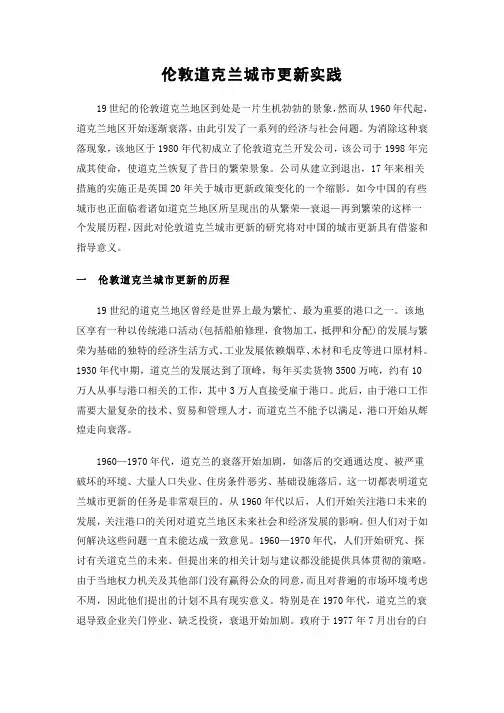
伦敦道克兰城市更新实践19世纪的伦敦道克兰地区到处是一片生机勃勃的景象,然而从1960年代起,道克兰地区开始逐渐衰落,由此引发了一系列的经济与社会问题。
为消除这种衰落现象,该地区于1980年代初成立了伦敦道克兰开发公司,该公司于1998年完成其使命,使道克兰恢复了昔日的繁荣景象。
公司从建立到退出,17年来相关措施的实施正是英国20年关于城市更新政策变化的一个缩影。
如今中国的有些城市也正面临着诸如道克兰地区所呈现出的从繁荣—衰退—再到繁荣的这样一个发展历程,因此对伦敦道克兰城市更新的研究将对中国的城市更新具有借鉴和指导意义。
一 伦敦道克兰城市更新的历程19世纪的道克兰地区曾经是世界上最为繁忙、最为重要的港口之一。
该地区享有一种以传统港口活动(包括船舶修理,食物加工,抵押和分配)的发展与繁荣为基础的独特的经济生活方式。
工业发展依赖烟草、木材和毛皮等进口原材料。
1930年代中期,道克兰的发展达到了顶峰,每年买卖货物3500万吨,约有10万人从事与港口相关的工作,其中3万人直接受雇于港口。
此后,由于港口工作需要大量复杂的技术、贸易和管理人才,而道克兰不能予以满足,港口开始从辉煌走向衰落。
1960—1970年代,道克兰的衰落开始加剧,如落后的交通通达度、被严重破坏的环境、大量人口失业、住房条件恶劣、基础设施落后。
这一切都表明道克兰城市更新的任务是非常艰巨的。
从1960年代以后,人们开始关注港口未来的发展,关注港口的关闭对道克兰地区未来社会和经济发展的影响。
但人们对于如何解决这些问题一直未能达成一致意见。
1960—1970年代,人们开始研究、探讨有关道克兰的未来。
但提出来的相关计划与建议都没能提供具体贯彻的策略。
由于当地权力机关及其他部门没有赢得公众的同意,而且对普遍的市场环境考虑不周,因此他们提出的计划不具有现实意义。
特别是在1970年代,道克兰的衰退导致企业关门停业、缺乏投资,衰退开始加剧。
政府于1977年7月出台的白皮书,显示内城问题越来越受到政府的关注,但长期看来,由于缺乏财政资金,一些有利于城市更新的重大项目实施起来较为困难。
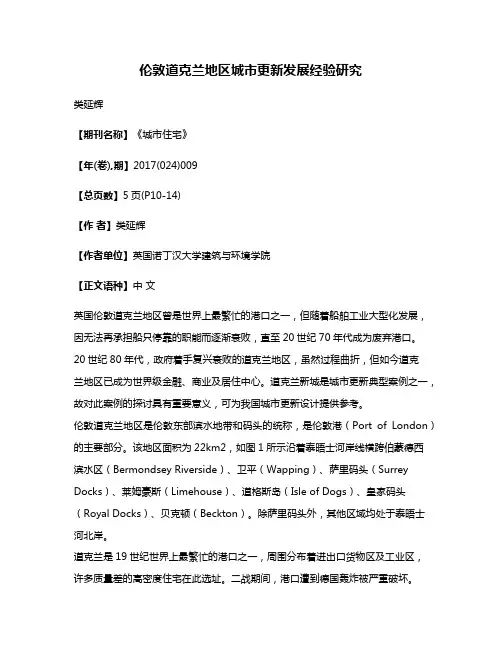
伦敦道克兰地区城市更新发展经验研究类延辉【期刊名称】《城市住宅》【年(卷),期】2017(024)009【总页数】5页(P10-14)【作者】类延辉【作者单位】英国诺丁汉大学建筑与环境学院【正文语种】中文英国伦敦道克兰地区曾是世界上最繁忙的港口之一,但随着船舶工业大型化发展,因无法再承担船只停靠的职能而逐渐衰败,直至20世纪70年代成为废弃港口。
20世纪80年代,政府着手复兴衰败的道克兰地区,虽然过程曲折,但如今道克兰地区已成为世界级金融、商业及居住中心。
道克兰新城是城市更新典型案例之一,故对此案例的探讨具有重要意义,可为我国城市更新设计提供参考。
伦敦道克兰地区是伦敦东部滨水地带和码头的统称,是伦敦港(Port of London)的主要部分。
该地区面积为22km2,如图1所示沿着泰晤士河岸线横跨伯蒙德西滨水区(Bermondsey Riverside)、卫平(Wapping)、萨里码头(Surrey Docks)、莱姆豪斯(Limehouse)、道格斯岛(Isle of Dogs)、皇家码头(Royal Docks)、贝克顿(Beckton)。
除萨里码头外,其他区域均处于泰晤士河北岸。
道克兰是19世纪世界上最繁忙的港口之一,周围分布着进出口货物区及工业区,许多质量差的高密度住宅在此选址。
二战期间,港口遭到德国轰炸被严重破坏。
20世纪50年代,战后重建给该地区带来短暂的繁华。
但60年代至70年代初,船只大型化及集装箱化发展,以人工作业和小型船只为主的道克兰地区码头已无法适应发展需要。
截至20世纪70年代,道克兰地区码头全部关闭,沦为废弃港口,仓库空置(见图2)。
失业率高,居住条件恶劣,基础设施匮乏,经济发展停滞等一系列社会问题突出,居民被迫离开,道克兰地区的衰败引起英国政府的高度重视。
1979年,英国城市建设政策有所转变,提倡以市场为导向的城市更新,鼓励私人资本参与城市建设。
1980年,《地方政府、规划以及土地法案》通过,授权国家环境部建立城市发展公司。
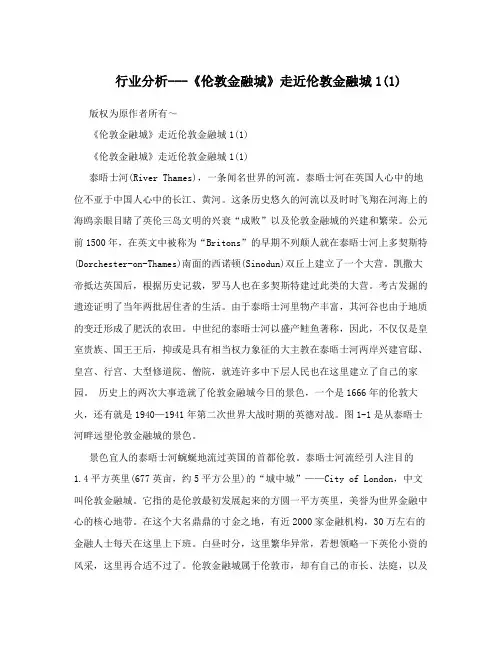
行业分析---《伦敦金融城》走近伦敦金融城1(1) 版权为原作者所有~《伦敦金融城》走近伦敦金融城1(1)《伦敦金融城》走近伦敦金融城1(1)泰晤士河(River Thames),一条闻名世界的河流。
泰晤士河在英国人心中的地位不亚于中国人心中的长江、黄河。
这条历史悠久的河流以及时时飞翔在河海上的海鸥亲眼目睹了英伦三岛文明的兴衰“成败”以及伦敦金融城的兴建和繁荣。
公元前1500年,在英文中被称为“Britons”的早期不列颠人就在泰晤士河上多契斯特(Dorchester-on-Thames)南面的西诺顿(Sinodun)双丘上建立了一个大营。
凯撒大帝抵达英国后,根据历史记载,罗马人也在多契斯特建过此类的大营。
考古发掘的遗迹证明了当年两批居住者的生活。
由于泰晤士河里物产丰富,其河谷也由于地质的变迁形成了肥沃的农田。
中世纪的泰晤士河以盛产鲑鱼著称,因此,不仅仅是皇室贵族、国王王后,抑或是具有相当权力象征的大主教在泰晤士河两岸兴建官邸、皇宫、行宫、大型修道院、僧院,就连许多中下层人民也在这里建立了自己的家园。
历史上的两次大事造就了伦敦金融城今日的景色,一个是1666年的伦敦大火,还有就是1940—1941年第二次世界大战时期的英德对战。
图1-1是从泰晤士河畔远望伦敦金融城的景色。
景色宜人的泰晤士河蜿蜒地流过英国的首都伦敦。
泰晤士河流经引人注目的1.4平方英里(677英亩,约5平方公里)的“城中城”——City of London,中文叫伦敦金融城。
它指的是伦敦最初发展起来的方圆一平方英里,美誉为世界金融中心的核心地带。
在这个大名鼎鼎的寸金之地,有近2000家金融机构,30万左右的金融人士每天在这里上下班。
白昼时分,这里繁华异常,若想领略一下英伦小资的风采,这里再合适不过了。
伦敦金融城属于伦敦市,却有自己的市长、法庭,以及近千名警察,形成一整套严格的管理体系。
按照英国王室宪章的规定,即使英国女王想进城,也必须事先征得伦敦金融城市长的同意。

城市有机更新案例城市有机更新是指在城市发展过程中,通过对旧城区的改造和再利用,使其逐渐恢复活力并与周围环境相协调的发展模式。
下面列举了十个城市有机更新的案例。
1. 伦敦金丝雀码头(Canary Wharf)项目:伦敦金丝雀码头曾是一个废弃的港口区,经过有机更新后,成为了一个现代化的商业金融区,拥有高楼大厦、购物中心、文化设施等,成为了伦敦的新地标。
2. 巴黎勒芒区(Le Marais)项目:巴黎勒芒区是一个历史悠久的地区,经过有机更新,保留了原有的历史建筑和街道布局,同时引入了新的商业和文化设施,使其成为了一个繁华的时尚区。
3. 纽约高线公园(High Line Park)项目:纽约高线公园是一个废弃的高架铁路,经过有机更新后,被改造成了一个城市公园,成为了市民休闲娱乐的热门去处。
4. 上海外滩(The Bund)项目:上海外滩是一个具有历史意义的滨江区域,经过有机更新,保留了原有的历史建筑风貌,并引入了新的商业和文化设施,成为了上海的标志性景点。
5. 柏林普伦茨劳贝格区(Prenzlauer Berg)项目:柏林普伦茨劳贝格区是一个曾经的工业区,经过有机更新,保留了原有的工业建筑,并改造成了一个艺术区,吸引了众多艺术家和创意人才。
6. 东京涩谷区(Shibuya)项目:东京涩谷区是一个繁华的商业区,经过有机更新,改造成了一个现代化的购物和娱乐中心,成为了东京的时尚潮流中心。
7. 芝加哥密歇根大道(Michigan Avenue)项目:芝加哥密歇根大道是一个历史悠久的购物街区,经过有机更新,保留了原有的历史建筑,并引入了新的商业设施,成为了芝加哥的商业中心。
8. 华盛顿特区西南区(Southwest Waterfront)项目:华盛顿特区西南区是一个废弃的港口区,经过有机更新,改造成了一个现代化的滨水区,拥有酒店、商业设施、公共广场等,成为了华盛顿的新地标。
9. 温哥华雅芳区(Yaletown)项目:温哥华雅芳区是一个曾经的工业区,经过有机更新,保留了原有的工业建筑并改造成了一个现代化的住宅区,成为了温哥华的时尚居住区。
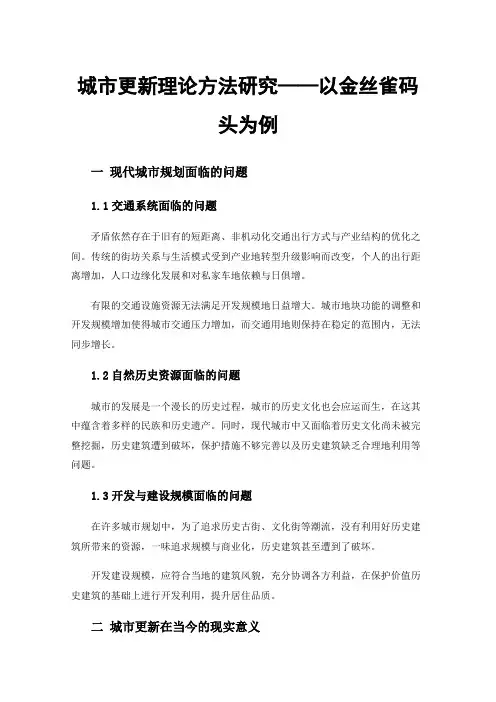
城市更新理论方法研究——以金丝雀码头为例一现代城市规划面临的问题1.1交通系统面临的问题矛盾依然存在于旧有的短距离、非机动化交通出行方式与产业结构的优化之间。
传统的街坊关系与生活模式受到产业地转型升级影响而改变,个人的出行距离增加,人口边缘化发展和对私家车地依赖与日俱增。
有限的交通设施资源无法满足开发规模地日益增大。
城市地块功能的调整和开发规模增加使得城市交通压力增加,而交通用地则保持在稳定的范围内,无法同步增长。
1.2自然历史资源面临的问题城市的发展是一个漫长的历史过程,城市的历史文化也会应运而生,在这其中蕴含着多样的民族和历史遗产。
同时,现代城市中又面临着历史文化尚未被完整挖掘,历史建筑遭到破坏,保护措施不够完善以及历史建筑缺乏合理地利用等问题。
1.3开发与建设规模面临的问题在许多城市规划中,为了追求历史古街、文化街等潮流,没有利用好历史建筑所带来的资源,一味追求规模与商业化,历史建筑甚至遭到了破坏。
开发建设规模,应符合当地的建筑风貌,充分协调各方利益,在保护价值历史建筑的基础上进行开发利用,提升居住品质。
二城市更新在当今的现实意义2.1从旧城改造到有机更新现在的城市正从旧城改造向着城市有机更新的目标转变。
一开始的旧城改造常常伴随着大规模地拆迁与重建,现在慢慢摆脱了此种做法向着有机更新过渡。
将城市作为一个生命体并不断的更新并激发活力,完成自身的新陈代谢的过程。
2.2从大规模的建设转变到城市针灸一个城市的规划是持续发展的,同时也应该是抛去大规模的、断裂式的发展,坚持小规模渐进式的发展。
同时,城市的更新发展应该具有一定的修复功能,如同针灸一样逐渐对城市的弊端进行治疗修复。
2.3从单一维度到综合的维度在城市的开发维度方面,城市规划的开发维度应该是多方向、多维度的,而不是单一地发展,进而形成有效的城市管理模式。
城市发展应该从单一的维度比如经济方面,向多维度的更新方向转变。
真正的城市更新的成功依赖于各方合作。


伦敦国际航运中心模式变迁之启示伦敦曾是第一代国际航运中心,拥有成熟的连锁航运服务,如今伦敦港口的主体已外移到距伦敦市中心约40公里的提尔伯里港,在世界集装箱港口100强之外,航运中心的物理功能已下降,但仍是重要的世界航运“神经”节点,是全球无可争议的航运定价中心和管理中心,并通过海事服务创造比传统港口业更大的收益,实现航运中心模式的完美转型,主要归功于以下几点:1、港区分离、传统港口外迁19世纪末、20世纪初,伦敦码头区曾经是当时全球最大的港务综合区之一。
20世纪40年代,随着港口硬件设施外移到离市中心以东40公里的提尔伯里和沿河下游,伦敦采取了港区分离的模式,陆续关闭紧挨市区的两大港区。
为适应集装箱船靠泊需要,从1967年起在泰晤士河口以北离伦敦市中心近100公里的费利克斯托兴建集装箱枢纽港。
1990年又在泰晤士河口离市中心56公里外,新建泰晤士港,而原市内码头区已用于非海运的商业办公、娱乐休闲和房产开发,并依靠波罗的海航运交易所,在市中心城区建设航运服务软环境,大力发展产业链上游产业,如航运融资、海事保险、海事仲裁等。
2、引入私人公司对老码头改造二战以后,在英国工业总体衰退的大形势下,老码头已经不能适应新的航运技术和现代交通联系的要求,伦敦码头区逐渐衰退。
英国政府通过立法向伦敦道克兰码头区城市开发公司进行授权,对道克兰码头区进行重新规划开发。
开发于1981年正式启动,1998年结束,历时17年。
开发目标是将该地区打造成“伦敦的一个全新的金融、商业、商务区,成为伦敦的一个新地标和最有活力的区域”,为了推动伦敦码头区的开发,国家投入了大量资金,主要用于购买和平整土地、环境整治以及基础设施建设,拆巨资兴建了35公里的无人驾驶轻轨系统和伦敦城市机场,使得码头区土地迅速升值。
同时政府还出台了大量的优惠政策,进一步吸引私人资金。
伦敦码头区的开发取得了巨大的成功,一方面,它成功地帮助伦敦市实现了城市复兴与经济转型的目标;另一方面,在政府财政困难的情况下,成功地吸引了私人资金,顺利实施了码头区的开发。
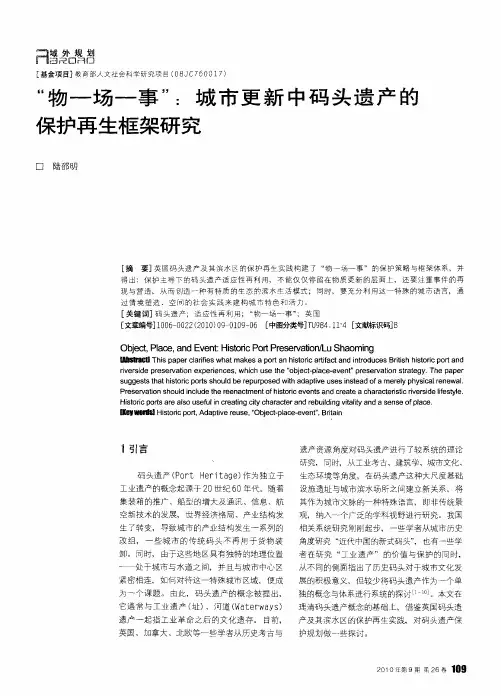

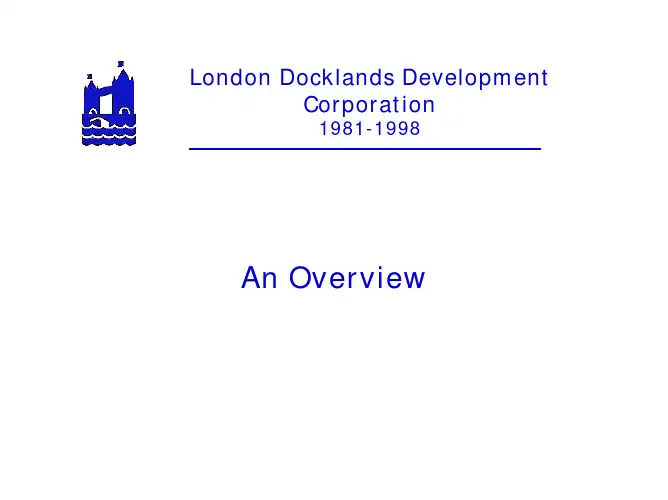

城市更新的3种方式,英美荷法有哪些经验做法?今天我们与您分享四个国外城市更新的经验做法,以及对我国存量用地再开发再更新的的借鉴与启示。
首先,城市更新的方式主要包括三种:第一种是重建,对城市中严重衰退地区进行清除并作合理的使用;第二种重整,对城市中整体功能仍能适应需求,但出现衰退迹象的地区进行环境改善或局部拆除重建;第三种是维护,针对城市中环境状况良好的地区予以保护和维修, 并适当补充必要设施以防止衰退现象发生。
本文将介绍部分发达国家三种方式在更新过程中配合使用,使得城市焕发出新生机。
比如在一、英国自下而上的社区规划模式英国是最早开始城市化的国家之一,其真正意义上的城市更新始于上世纪30年代的清除贫民窟计划。
1930年,英国工党政府制定格林伍德住宅法,采用''建造独院住宅法〃和〃最低标准住房〃相结合的办法,要求地方政府提出消除贫民窟的5年计划。
在清除地段建造多层出租公寓,并在市区以外建一些独院住宅村。
这一法规首次提出对清除贫民窟提供财政补助。
英国政府建立了城市开发公司(如伦敦道克兰区发展公司Dockland Development),隶属于环境部,由国家政府直接控制并委派官员负责,不受地方管制。
其主要负责是土地开发的前期准备工作,如强制收购、土地整理等,将土地出售给合适的开发商;同时培育资本市场、土地市场和住宅市场等,利用国家公共资金的投入和一些优惠政策,刺激更多的私人资金注入指定区域。
早期,英国城市更新的初期是政府主导,政府及公共部门的拨款补助为主要资金来源。
随后,政府和城市开发公司设立企业区,通过优惠政策鼓励私人投资,并把投资从富裕地区引入旧城区的开发与建设中。
1980年,英国颁布了《地方政府、规划和土地法案》,在立法上确定了城市开发公司的目的是通过有效地使用土地和建筑物,鼓励现有的和新的工商业发展,创造优美宜人的城市环境,提供住宅和社会设施以鼓励人们生活、工作在这些地区。
自此,英国政府的城市更新政策也有了重大转变,逐步发展为以市场为主导、以引导私人投资为目的,最后公、私、社区三方合作,让公众参与到城市更新的过程中,变被动为主动,更快更好地推动了城市更新进程。
伦敦码头区开发案例研究(上篇)上海城投王强第一部分20世纪七八十年代开始,在英国伦敦东区的一块被长期废弃的码头区域展开了了一次令人叹为观止的城市复兴式的开发活动,英国开发者,历时超过二十年,化腐朽为神奇,将一片数世纪以来无人问津的土地转变成为举世闻名的国际金融中心。
伦敦码头区开发也成为全球范围内城市复兴的经典案例,吸引世界上无数的同行、学者和投资家前往观摩和学习。
我们之所以选择伦敦码头区开发案例做研究,认为其成功对城投总公司未来的区域开发和城镇开发有丰富的借鉴意义。
由于所搜集的资料比较翔实,该案例在多个方面存在成功的特色,所以本次研究系列化,力图比较全面深入地剖析此案例。
一、开发前的状况伦敦码头区开发以前无论在地理上还是社会情感上都与伦敦的其他地区相距较远,从伦敦没有交通直达,并在该区域内几乎没有公共交通,在伦敦绝大多数民众认为此地就根本不值一去。
整个码头区以前是英国东印度公司的专用码头,但该地区十九世纪末叶就开始被废弃。
时过境迁,到1970年代,该地区充斥了一系列严重的社会和经济问题,生活在当地的人们相当贫困,住宅破敝,毫无获得教育和就业之希望,整个土地一片萧瑟和苍凉的景象。
二、开发机制1.开发思想的演变城市的再开发是将英国从战争的创伤中迅速挽救出来的中重要手段。
在战后的初期,出现了一系列城市开发的创新政策和手段,例如伦敦内城的大片区域的综合再开发和新城建设。
然而,在之后的二三十年内,这些开发政策和活动受到了公众和学者们的质疑。
新城并不受到当地居民的欢迎,因为这需要经常较长距离的通勤到达伦敦市中心主要的功作和娱乐场所,而“综合开发区域”对原有的居民区和传统建筑的破坏代之以大量的办公楼和购物中心的建设受到了广泛的批评和厌恶。
从而在1970年代,便出现了对传统住宅和街区进行保护的开发模式,而对于伦敦码头区的开发莫衷一是,传统的土地利用模式被放弃。
码头区本身的条件已经不适于日益增长的集装箱化的国际航运的模式,最后连伦敦港务局也放弃了对此地在开发的念头,于是造成了更多的空闲和荒芜的土地。
独家解密北京CBD东扩一号方案张璐晶【摘要】@@ 3.99平方公里的土地会创造怎样的经济价值?如果在这之上再增加3平方公里昵?rn十年前,当北京市朝阳区政府提出要建立"CBD"(Central Business District 的英文缩写,意为中央商务区)概念的时候,人们也许不会想到10年后的今天,这个面积为3.99平方公里的热土,会成为北京市经济发展和区域税收的"黄金地段".【期刊名称】《中国经济周刊》【年(卷),期】2010(000)022【总页数】8页(P10-17)【作者】张璐晶【作者单位】【正文语种】中文3.99平方公里的土地会创造怎样的经济价值?如果在这之上再增加3平方公里呢? 十年前,当北京市朝阳区政府提出要建立“CBD”(Central Business District 的英文缩写,意为中央商务区)概念的时候,人们也许不会想到10年后的今天,这个面积为3.99平方公里的热土,会成为北京市经济发展和区域税收的“黄金地段”。
据北京朝阳区第二次全国经济普查数据显示,截至2008年底,北京CBD功能区共入驻商务服务业单位7493家,占全区商务服务业总单位数的57.7%;实现收入1130.5亿元,占全区商务服务业总收入的75.8%;实现利润232.5亿元,占全区商务服务业总利润的48.9%;2008年北京CBD区域内77座楼宇中的企业税收总额为74.1亿元,约占朝阳区税收总额的22%,其中税收贡献最高的写字楼纳税高达17亿元。
“宁租国贸一间屋,不租他处一栋楼”的说法,在标榜企业身份的同时似乎也为这个寸土寸金的地段披上了一袭华丽的衣衫。
在各种令人兴奋的经济数字背后,这里的人居生活现状又是怎样的呢?作为获得“北京CBD东扩区规划方案”一等奖的一号方案,其设计者美国SOM建筑师事务所向《中国经济周刊》独家披露该方案设计的前前后后。
我们按图索骥试着畅想,在十年之后,在东扩了3平方公里之后,新的6.99平方公里CBD将向人们展现一个怎样的未来图景?时间回到一年前。
伦敦Charter码头区改造,英国
佚名
【期刊名称】《城市建筑》
【年(卷),期】2007(000)006
【摘要】Charter码头是英国后工业时代的产物,这片工厂搬迁后废弃的工业用地
被称为“棕色用地”。
20世纪90年代后期,作为停车场的Charter码头区荒凉而
破败,但因其位于泰晤士河边、临近Kingston市镇广场,所以具有较大的发展潜力。
该地块可与小镇中心的南向建立联系,并在市镇广场与河边区域之间形成固定的人流,从而营造新的场所空间。
【总页数】2页(P78-79)
【正文语种】中文
【相关文献】
1.滨水区活力营造策略探析——以英国布里斯托尔码头区为例 [J], 周昊天;阎瑾;赵红红
2.英国卡迪夫大学住区规划设计课程概览——以伦敦巴比坎住区改造为例 [J], 冯
霁飞;钱云
3.迎接奥运会英国伦敦塔桥进行照明改造 [J], 无
4.黄浦江滨江码头遗产景观规划设计探索与实践——以南码头区域贯通及景观提升改造工程为例 [J], 沈雨
5.伦敦码头区再开发成功的经验与启示 [J], 顾英
因版权原因,仅展示原文概要,查看原文内容请购买。
What was the LDDC?THE Corporation was an urban development corporation, the second to be established by the then Secretary of State for the Environment, Michael Heseltine, under s.136 of the Local Government, Planning and Land Act 1980. Its object was to secure the regeneration of the London Docklands Urban Development Area (UDA) comprising 8½ square miles of East London in the Boroughs of Tower Hamlets, Newham and Southwark. This was a response to a huge decline in the economy of the area brought about by the progressive closure of the 1960s onwards. Years later, in his book Life in the Jungle*, Michael Heseltine wrote:"I had found myself in in small plane, heading in that direction by way of the London's East End. My indignation at what was happening on the South Bank was as nothing compared to my reaction to the immense tracts of dereliction I now observed. The rotting docks - long since abandoned for deep-water harbours able to take modern container ships downstream - the crumbling infrastructure that had once supported their thriving industry and vast expanses of polluted land left behind by modern technology and enhanced environmentalism. The place was a tip: 6,000 acres of forgotten wasteland"There had been attempts by the local authorities to deal with this. (These are described in an LDDC monograph "Initiating Urban Change" published in 1997). These efforts were perceived by the Government to be much too slow and there was a need for resources on a scale which it would only make available through a focussed agency of its own. LDDC was wholly financed by grant from the Government and the income generated by the disposal of land for housing, industrial and commercial development.(* Hodder and Stoughton, 2000, ISBN 0 340 73915 0 - see pages 130,153, 200, 211-214, 380, 397-398 and 515. A mong LDDC veterans Michael Heseltine is often thought of as the father of the Corporation - click the thumbnail to the right to see a 1987 picture of Michael Heseltine with LDDC staff)Aims and powersAlthough its influence in the area was undoubtedly very strong, LDDC's powers were in practice pretty limited:●It had powers to acquire land by agreement or compulsory purchase and, in thecase of the large amount of land in the public sector, there were powers for itto be vested in the Corporation by the Secretary of State. This ensured asupply of land for development.●It took over from the London Boroughs their planning (but not their planmaking) powers. This was response to the Government's perception that theBoroughs had been too restrictive in exercising their development control and other powers because their plans for the area were outmoded andinappropriate.●It had powers, and the resources, to provide new (or refurbish the existing)infrastructure.Apart from planning all other public services (housing, education, health etc) remained firmly in the hands of the Boroughs and other public agencies although the Corporation could and did provide funds for their development and improvement. TheCorporation's lack of remit in this respect was often misunderstood by those who felt the LDDC should do more to revitalise these services for the benefit of local people. The T askTHE 1980 Act requires an urban development corporation "to secure the regeneration of its area, by bringing land and buildings into effective use, encouraging the development of existing and new industry and commerce, creating an attractive environment and ensuring that housing and social facilities are available to encourage people to live and work in the area".Against such a brief the task facing the Corporation in 1981 was daunting. A Regeneration Research Report published in 1997 by the Department of the Environment, Transport and the Regions (DETR) analysed the problems of the Docklands as follows:●The area experienced catastrophic job losses over a short period of time, as theDocks closed. Between 1978 and 1983, over 12,000 jobs were lost. The skills of the local population, directed at blue collar work, were inappropriate formany of the growth areas of the London economy.● A high proportion of land was held by public bodies who had neither the willnor the capital to make it available for redevelopment. Relatively little landwas in private holdings. Thus the supply of land was constrained by a patternof ownership which was not market sensitive.●The extent of dereliction in parts of Docklands was so severe that the costs ofdevelopment would be very high and uncertain, lowering the attractiveness of the area to investors. External intervention was needed to meet extra-ordinary land reclamation costs and to improve developer confidence more generally.●Many development sites were poorly served by the local infrastructure - theprovision of which would be essential for these sites to be developed. Poorstrategic links between Docklands and the rest of London, the country andinternationally, would have created additional costs for employers thusdepressing the potential returns on investment.●The market alone was unlikely to provide the environmental improvements(including landscaping, refurbishment of the dock estate or restoration ofprominent landmarks) or the provision of infrastructure and amenities thatwere essential if Docklands was to cast off its run-down image and become an attractive place in which to live and conduct business.●There were certain gaps in available information that were hindering theoperation of markets - for example, the almost complete absence of privatehouse-building in the area for years meant that housing developers had no idea on the potential return for new-build, thus magnifying the risk to developersand deterring investment.●This combination of factors made it difficult for the market, without externalintervention, to reverse the steep cycle of decline experienced by Docklandsbefore the establishment of LDDC.AchievementsTHE Corporation was at work for 17 years. In its final Annual Report in 1998 it headlined its achievements as follows:●£1.86 billion in public sector investment●£7.7 billion in private sector investment●1,066 acres of land sold for redevelopment●144 km of new and improved roads●the construction of theDocklands Light Railway●25 million sq feet of commercial /industrial floorspace built●1,884 acres of derelict land reclaimed●24,046 new homes built●2,700 businesses trading●contributions to 5 new health centres and the redevelopment of 6 more●funding towards 11 new primary schools, 2 secondary schools, 3 post-16colleges and 9 vocational training centres●94 awards for architecture, conservation and landscaping●85,000 now at work in London DocklandsThere is more detailed information in the LDDC's 1998 Regeneration Statement and its nine monographs describing its work in the various fields in which it operated - Top of PageHow well did LDDC succeed?OPINIONS vary about how well the Corporation succeeded in its regeneration task and the extent to which its work was a benefit to the original inhabitants of its area. Another Regeneration Research Report published by DETR in 1998 has this to say:- ●The LDDC has successfully tackled the widespread multiple market failurewhich prevailed in the London Docklands in 1981. Failures in land, housingand commercial property markets have been addressed and labour marketfailures have been alleviated by a combination of training projects,improvements in accessibility in and out of Docklands and the creation of new local jobs.●When all projects are completed the total public sector cost of regeneratingDocklands will be of the order of £3,900 million, 48% incurred by the LDDC, 25% by London Transport and 27% by the Isle of Dogs Enterprise Zone.Almost half the public sector cost of regenerating Docklands was devoted totransport infrastructure.●Private sector investment in Docklands, at £8,700 million by March 1998, hasbeen substantial and will continue to increase well into the next century.The LDDC has generated a wide range of economic, environmental and social benefits. Prominent amongst these are over 24,000 housing units and over80,000 gross jobs within the Urban Development Area (UDA). Housing tenure is substantially more varied, employment is three times higher, the number of firms has increased fivefold and the new stock of housing will accommodate an additional 45,000 population.With respect to value-for-money, the evaluation concluded that every £1M of public sector cost generated net additional benefits in the UDA of 23 jobs,8500 sq m of office floorspace, 7.8 housing units plus many other diverse and intermediate benefits. Since almost all the costs have been incurred and some of the benefits have still to materialise, this cost-benefit ratio should be morefavourable by a third when the end state position is reached in 2010 or 2015.In spite of vociferous comments to the contrary over the life of the Corporation, the LDDC generated substantial benefits specifically for localcommunities and residents. The amount of new social housing is higher than it would have been in the absence of the Corporation.In the wider local economy, the net impact of LDDC activities is lower, but even so, the LDDC generated an additional 23,000 jobs in Central London by increasing the supply of high grade office accommodation which led to a more competitive financial centre.CompletionTHE Corporation, which was established on 2nd July 1981, was expected to need10-15 years to accomplish its task. In October 1994 it began by stages to withdraw. Bermondsey Riverside in Southwark was the first area to be "dedesignated" and the withdrawal process ended with the Royal Docks on 31st March 1998 although its task there was not fully complete. The Corporation was formally wound up on 30th June 1998.The FutureIN most of the LDDC's area the Corporation' work was sufficiently complete, and the momentum of regeneration such, that there was no need for a specialised agency to take over its role. The Boroughs and other local agencies were left to carry on the work. In the Royal Docks, however, the Corporation's there was a good deal of outstanding work. This was taken over by another agency of the central government, English Partnerships, working in collaboration with the London Borough of Newham to whom the LDDC's planning powers were restored. The joint team established for this purpose operates from offices on the north side of the Royal Albert Dock just opposite London City Airport.。